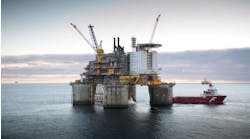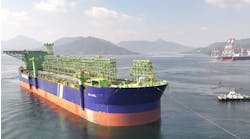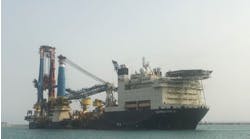Welded joints instead of flanges for Schiehallion
The Schiehallion and Loyal fields are in 1,300 ft of water below the NW Atlantic, 93 miles west of the Shetland Islands. The fields are being developed jointly by two groups of companies managed by BP Exploration.When complete, the fields, known as Schiehallion, will include five drilling centers with a total of 29 wells. There will be 16 production wells, 12 water injection wells, and one well for gas disposal. Because of its location, the complete subsea system has been designed for diverless installation and a maintenance-free, 20-year service life.
Kv?rner Oil and Gas is responsible for design of the subsea production system. The company specified that the water injection lines be made of carbon steel pipe with a polyethylene (PE) liner. The steel pipe would provide the necessary strength to withstand installation and environmental loadings and the high pressure used in water injection lines. The PE pipe would protect the carbon steel from internal corrosion.
The resulting pipeline would meet the maintenance-free, 20-year service life requirement at one-third to one-half the cost of stainless steel, and it would be much lighter and easier to handle.
Pipe lining system
Swagelining, a pipe lining system developed by BG plc (formerly British Gas plc), has been used successfully for high-pressure water injection lines in the Foinaven deepwater field. The lining also has been used above ground in the Rio Neuquen oilfield on the high plateaus of southern Argentina.Foinaven proved the system in 200-mm and 250-mm diameter pipes at depths up to 1,968 ft. In addition, Foinaven proved that long lengths of swagelined pipe could be reeled on and off ships for transportation to an offshore site and deployment in the oilfield.
Swagelining uses PE pipe which has an outside diameter (OD) slightly larger than the inside diameter of the pipe to be lined. During the installation process, the PE pipe is pulled through a die to temporarily reduce its OD.
This reduction allows the PE pipe to be easily pulled through the outer pipe. When the pulling force has been disconnected, the PE pipe begins to return to its original OD. Within hours, the PE pipe will be pressing tightly against the inside of the outer pipe.
The Swagelining process has been used successfully for many years to line high-pressure pipelines both onshore and off. However, in onshore installations the lined steel pipe had been rejoined with flanged fittings. Flanged fittings were not used at Schiehallion because of their potential for leaks, and flanges would result in a significant reduction in installation efficiency. Therefore, BG plc developed a coupling that allowed the Swagelined pipe to be welded together, eliminating the potential for leaks.
Compression fittings
An associated process known as WeldLinktrademark is a compression fitting which makes it possible to weld lined pipe together without harming the PE liner. The concept, designed by BG, features short sections of the same carbon steel pipe used throughout the water injection lines. The sections are machined to remove a certain amount of internal diameter, then a special inlay of corrosion-resistant alloy (CRA) is added to protect the inside of the fitting against the corrosive injection water.After the interior is machined smooth, except for raised ridges to grip the PE liner, the fitting can be welded onto each end of the 1,690 ft lengths of steel pipe. Later, after the PE pipe has been installed inside the steel pipe, a compression ring made of the same CRA material would be inserted to press the PE pipe into the ridges.
This would form a permanent connection between the PE pipe and the carbon steel pipe. Since the PE pipe is cut short of the ends of the steel pipe, sections of the lined pipe can be welded together without melting the PE.
Charlie Tighe, director, QA Weld Tech, was responsible for the fabrication of the compression fittings, which have made the use of PE-lined pipe possible in both the Foinaven and Schiehallion fields.
"While the details of the manufacturing process are confidential, I can tell you the fittings were made to well-tried and tested procedures, and the integrity of the process was fully proven in the deep water of the Foinaven field. The process we employed was state-of-the-art weld cladding techniques using hot wire, fully automatic TIG welding. We are able to program the welding parameters to ensure that the procedures which have been developed and tested for this critical application are repeated exactly," he explained.
Swagelining steel pipes
Subsea Offshore was contracted by BP Exploration to install all the subsea infrastructure in the Schiehallion oilfield. Subsea subcontracted the installation of the production, water injection, and gas lines to McDermott Subsea Constructors.McDermott had been responsible for the successful installation of the subsea pipelines at Foinaven, and used the same crews and techniques at Schiehallion.
The carbon steel pipes arrived in 40-ft lengths at the Barmac fabrication facility at Ardesier, where they were assembled into 1,690-ft lengths and placed on racks, ready to be lined. Simultaneously, the 58.5 ft lengths of medium-density polyethylene (MDPE) were fused together, de-beaded inside and out, and tested prior to insertion into the steel pipes via the Swagelining process.
After the 1,690 ft sections of steel pipe were lined and tested, they were welded together and coiled onto a 21 ft diameter spool aboard McDermott's specially designed reel ship, Norlift. Norlift made three trips from the Barmac facility to Schiehallion to deploy the water injection lines.
Future use
The Swagelining process has allowed oil companies to reduce the cost of their water injection lines by at least 50%, so the use of this technology will undoubtedly expand. The cost savings lie in the weldless design and in the long maintenance-free life of the system.Oil company project engineers are constantly evaluating oilfields to determine whether or not they are economically viable. The ability to cut the cost of water injection lines in half might be enough to push some fields into the commercial category.
Copyright 1998 Oil & Gas Journal. All Rights Reserved.


